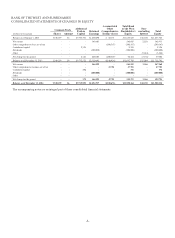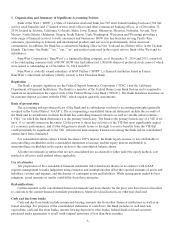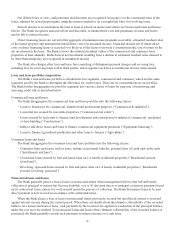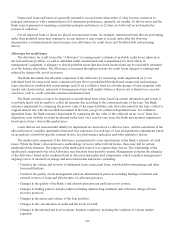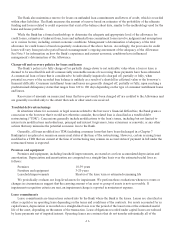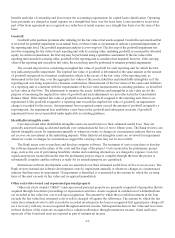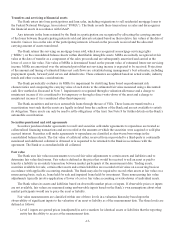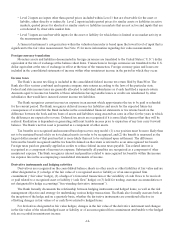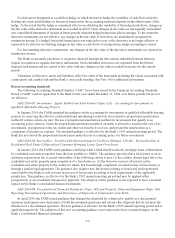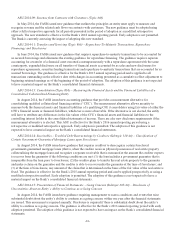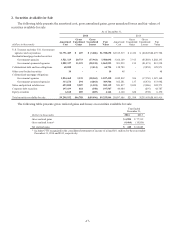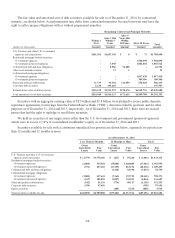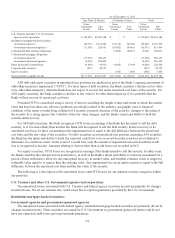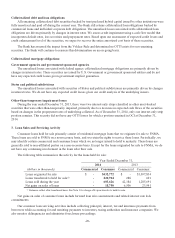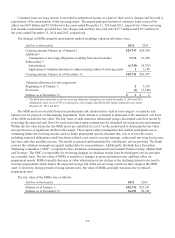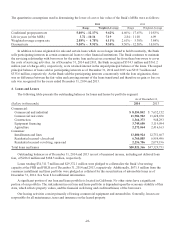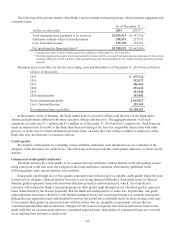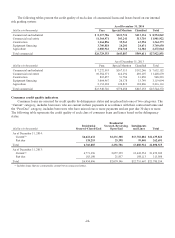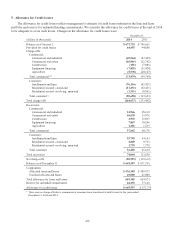Bank of the West 2014 Annual Report Download - page 17
Download and view the complete annual report
Please find page 17 of the 2014 Bank of the West annual report below. You can navigate through the pages in the report by either clicking on the pages listed below, or by using the keyword search tool below to find specific information within the annual report.For derivatives designated as a cash flow hedge, in which derivatives hedge the variability of cash flows related to
floating-rate assets and liabilities or forecasted transactions, the accounting treatment depends on the effectiveness of the
hedge. To the extent that the hedge is considered effective in offsetting the variability of the hedged cash flows, changes in
the fair value of the derivative instrument are recorded in AOCI. These changes in fair value are subsequently reclassified
into consolidated statements of income in future periods when the hedged transaction affects earnings. To the extent the
derivative instruments are not effective, any changes in the fair value of derivatives are immediately recognized in
noninterest income. If a hedged forecasted transaction is not expected to occur or the derivative is no longer effective or
expected to be effective in offsetting changes in fair value or cash flows of a hedged item, hedge accounting is ceased.
For free-standing derivative instruments, any changes in the fair value of the derivative instruments are reported in
noninterest income.
The Bank occasionally purchases or originates financial instruments that contain embedded features that may
require recognition as separate derivative instruments. Such embedded derivatives are separated from the hybrid
financial instruments and are carried at fair value with any changes in fair value recorded in income for the current
period.
Valuations of derivative assets and liabilities reflect the value of the instrument including the values associated with
counterparty risk, market risk and the Bank’s own credit standing. See Note 14 for additional information.
Recent accounting standards
The following Accounting Standard Updates (“ASU”) have been issued by the Financial Accounting Standards
Board (“FASB”) and are applicable to the Bank for the year ended December 31, 2014 or in future periods but are not
yet effective:
ASU 2014-01: Investments – Equity Method and Joint Venture (Topic 323) – Accounting for Investments in
Qualified Affordable Housing Projects
In January 2014, the FASB amended the guidance on the accounting for investments in qualified affordable housing
projects by removing the effective yield method and introducing a relatively less restrictive proportional amortization
method if certain criteria are met. The use of proportional amortization method for investments that qualify is an
accounting policy election. Under the proportional amortization method, an entity is allowed to amortize the cost of its
investments, in proportion to the tax credits and other tax benefits it receives, and present the amortization as a
component of income tax expense. The amended guidance is effective for the Bank’s 2015 annual reporting period. The
Bank has not elected the proportional amortization method as its accounting policy for future investments.
ASU 2014-04: Receivables – Troubled Debt Restructurings by Creditors (Subtopic 310-40) – Reclassification of
Residential Real Estate Collateralized Consumer Mortgage Loans Upon Foreclosure
In January 2014, the FASB issued guidance clarifying when a bank should reclassify mortgage loans collateralized
by residential real estate properties from the loan portfolio to OREO. The guidance specifies that a foreclosure or an in
substance repossession has occurred when either of the following criteria is met: (1) the creditor obtains legal title to the
residential real estate property upon completion of a foreclosure or; (2) the borrower conveys all interest in the
residential real estate property to the creditor to satisfy that loan through completion of a deed in lieu of foreclosure or
through a similar legal agreement. The guidance also requires new disclosures relating to foreclosed and repossessed
assets held by the Bank as well as loans in process of foreclosure according to local requirements of the applicable
jurisdiction. This guidance is effective for the Bank’s 2015 annual reporting period and may be applied either
prospectively or on a modified retrospective approach. The adoption of this guidance is not expected to have a material
impact on the Bank’s consolidated financial statements.
ASU 2014-08: Presentation of Financial Statements (Topic 205) and Property, Plant and Equipment (Topic 360) –
Reporting Discontinued Operations and Disclosures of Disposals of Components of an Entity
In April 2014, the FASB issued guidance that changes the threshold for a disposal to qualify as a discontinued
operation and requires new disclosures of both discontinued operations and certain other disposals that do not meet the
definition of a discontinued operation. The new guidance is effective for the Bank’s 2015 annual reporting period and is
applied prospectively. The adoption of this new accounting guidance is not expected to have a material impact on the
Bank’s consolidated financial statements.
-15-


